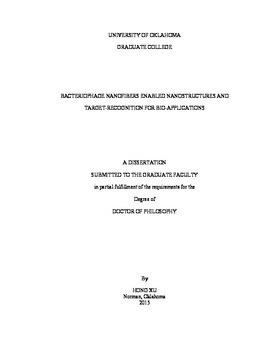| dc.description.abstract | Nanostructure is an object system that has dimensions on the nanoscale, i.e. between 0.1 and 100 nanometers. It includes nanotextured surface, nanotube, nanorod, nanofilament, nanoparticle, etc. The field of nanostructure science and technology is an explosively growing area in the past decades. Its tremendous potential for innovating the material science (referred as nanotechnology) and promising applications in the conjugation with current medicine (referred as nanomedicine) to preserve and improve human health is already clear, though the understanding of nanostructure functionalities is just beginning to reveal. Nanostructures can be considered as novel rising objects in the scientific community. However, to biologists, nanostructures are familiar since even the simplest organism contains astoundingly sophisticated elements functionalizing at the nanoscale which are still difficult even under the most advanced technologies, such as protein folding, formation of protein aggregates, pairing of nucleotides, and precise assembly of microbes.
Filamentous bacteriophage, the subject of this dissertation, is a representative instance of naturally biological nanostructures. Using standard molecular cloning technique, foreign peptides can be fused into the phage protein on the surface, termed as Phage Display technique. Although phage display has primarily been used for studying protein-protein interactions, it has two main research directions in the area of nanotechnology by using two different aspects of phage. The filamentous shape of the phage in the nano range provides the bio-template function of phages used within nanotechnology and material science while phage display can also provide an easy way to discover new targeting motifs, drugs or epitopes for medical applications. Both methods are becoming more popular, but the possibility of identifying targeting peptides against live cells and intact tissues including tumors greatly increases the potential application of using phage display in the biomedical field. My research followed the two main research directions of phage display in nanotechnology. I also focused on the uses and advances of phage display in the biomedical field.
Chapter 2 is the application of phage as a bio-template for bone regeneration: Oriented nucleation of hydroxylapatite crystals on self-assembled bacteriophage bundles. This work demonstrates the hydroxyapatite crystals can be nucleated on self-assembled bacteriophages in a preferred c-axis orientation. The resultant bacteriophage may serve as the building block to substitute collagen and form bone implant. It has a great potential in the field of tissue engineering. It also proved that the driving force of phage self-assembly is beta sheet secondary structure and beta sheet between phage bundles can induce the orientated nucleation of hydroxyapatite crystals. The beta sheet formation can be used as a general method to precisely control assemblies between engineerable biomaterials. In natural bone, HAP crystals are nucleated and grown with their c-axis preferentially parallel to collagen fibrils. In the work of Chapter 2, we also found that HAP crystals were also nucleated on EQ bundles with their c-axis preferentially parallel to phage bundles, which greatly mimicked the base level of hierarchical structure of natural bone. We further found that calcium ions were attracted to the glutamic acids and aspartic acids of peptide E and Q with a pattern matching with calcium ions on the (001) plane of HAP crystals. This specific matching then induced the HAP nucleation on the beta sheet and the growth along the c-axis. This work provided the proof for a new way of fabricating bone biomaterials by biomimicking and bioinspiration.
Chapter 3 is the phage as a bio-template for the synthesis of phage-gold nanocomposites. Bacteriophage-gold nanocomposite was constructed in the work of Chapter 3 to use as a model to study the optimum condition for best TEM imaging of bioinorganic nanohybrids. In this work, wild type M13 phage was combined with gold nanoparticles to form phage-gold nanocomposite. Most Au-NPs were aligned into large belts, forming a net-like structure. TEM imaging of negatively stained bioinorganic nanohybrids is a simple way to characterize these nanostructures that may have biomedical functions. By studying the effects of different factors on the negative staining of phage-gold nanocomposites, we found that the optimum staining conditions for these bioinorganic nanohybrids are using 0.5% UA solution with pH 4.5, staining for 10 seconds, and rapidly drying the stains. This work demonstrates that each staining factor has an influence to the final appearance of stained specimens and optimum staining condition needs to be customized to the individual type of bioinorganic nanohybrids. The effects of each staining factor and a general guideline for selecting staining condition were provided in this work. Therefore, this research provides useful information for the characterization of bioinorganic nanomaterials by TEM imaging. It will help the research in the field of nanomaterials and bionanotechnology.
Chapter 4 is discovering a novel targeting motif to mesenchymal stem cells by phage display to improve the efficiency and specificity of gene or drug delivery. In this work, we did cell panning on primary mesenchymal stem cells and identified peptide HMGMTK as MSC binding peptide. Further bioinformatics analysis suggests that peptide HMGMTK has high similarity to the signaling regions of chemokine CX3CL1. This may suggest a possible mechanism that could explain the MSC homing effect of the selected peptide. We then constructed a novel and effective mesenchymal stem cell gene delivery vector by liposome/protamine/DNA complex incorporating with identified MSC-targeting motif and Nuclear localized signal (NLS) motif. Through several evaluations, we proved that this resultant complex is multifunctional, effective, but low-cytotoxic MSC gene delivery vector. The transfection mediated by the resultant complex LPD+PA+NLS showed higher efficiency and specificity compared to those achieved by LPD only, LPD with control peptide, or LPD with PA only. Meanwhile, MTT results supported the low cytotoxicity of LPD+PA+NLS complex. Based on all the results, we can conclude that a novel rMSC binding peptide HMGMTK was identified and could be used to build up a promising gene carrier for facilitating liposome-mediated MSC gene delivery. | en_US |
